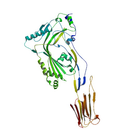| Record Information |
|---|
| Version | 2.0 |
|---|
| Creation Date | 2009-07-06 18:11:27 UTC |
|---|
| Update Date | 2014-12-24 20:25:45 UTC |
|---|
| Accession Number | T3D2601 |
|---|
| Identification |
|---|
| Common Name | Perfringolysin O |
|---|
| Class | Protein |
|---|
| Description | Perfringolysin O (PFO) or theta-toxin is produced by Clostridium perfringens. It is a member of the cholesterol-dependent cytolysin family. (1) |
|---|
| Compound Type | - Amide
- Amine
- Bacterial Toxin
- Natural Compound
- Organic Compound
- Protein
|
|---|
| Protein Structure |  |
|---|
| Synonyms | | Synonym | | Pfo | | Theta-toxin | | Thiol-activated cytolysin |
|
|---|
| Chemical Formula | Not Available |
|---|
| Average Molecular Mass | 55829.405 g/mol |
|---|
| CAS Registry Number | 71329-60-7 |
|---|
| Sequence | Not Available |
|---|
| Chemical Taxonomy |
|---|
| Description | Not Available |
|---|
| Kingdom | Organic Compounds |
|---|
| Super Class | Organic Acids |
|---|
| Class | Carboxylic Acids and Derivatives |
|---|
| Sub Class | Amino Acids, Peptides, and Analogues |
|---|
| Direct Parent | Peptides |
|---|
| Alternative Parents | Not Available |
|---|
| Substituents | Not Available |
|---|
| Molecular Framework | Not Available |
|---|
| External Descriptors | Not Available |
|---|
| Biological Properties |
|---|
| Status | Detected and Not Quantified |
|---|
| Origin | Exogenous |
|---|
| Cellular Locations | Not Available |
|---|
| Biofluid Locations | Not Available |
|---|
| Tissue Locations | Not Available |
|---|
| Pathways | Not Available |
|---|
| Applications | Not Available |
|---|
| Biological Roles | Not Available |
|---|
| Chemical Roles | Not Available |
|---|
| Physical Properties |
|---|
| State | Liquid |
|---|
| Appearance | Clear solution. |
|---|
| Experimental Properties | | Property | Value |
|---|
| Melting Point | Not Available | | Boiling Point | Not Available | | Solubility | >10 mg/mL | | LogP | Not Available |
|
|---|
| Predicted Properties | Not Available |
|---|
| Spectra |
|---|
| Spectra | | Spectrum Type | Description | Splash Key | Deposition Date | View |
|---|
|
|---|
| Toxicity Profile |
|---|
| Route of Exposure | Ingestion (4) ; inhalation (4) ; dermal (4) |
|---|
| Mechanism of Toxicity | Perfringolysin O binds to cholesterol on eukaryotic cell membranes, then forms oligomeric pores. This causes membrane damage and lysis of the cell. (1) |
|---|
| Metabolism | Free toxin may be removed by opsonization via the reticuloendothelial system (primarily the liver and kidneys) or it may be degraded through cellular internalization via the lysosomes. Lysosomes are membrane-enclosed organelles that contain an array of digestive enzymes, including several proteases. |
|---|
| Toxicity Values | LD50: 13-16 ug/mg (Intravenous, Mouse) (2) |
|---|
| Lethal Dose | Not Available |
|---|
| Carcinogenicity (IARC Classification) | No indication of carcinogenicity to humans (not listed by IARC). |
|---|
| Uses/Sources | Perfringolysin O (PFO) is produced by Clostridium perfringens. (1) |
|---|
| Minimum Risk Level | Not Available |
|---|
| Health Effects | Perfringolysin O (PFO) is produced by Clostridium perfringens. Clostridium perfringens can cause infections producing tissue necrosis and clostridial myonecrosis. Ingestion causes food poisoning. (1, 3) |
|---|
| Symptoms | Ingestion of Clostridium perfringens causes food poisoning characterized by colic, diarrhoea and sometimes nausea. Infections show evidence of tissue necrosis, bacteremia, emphysematous cholecystitis, and gas gangrene, which is also known as clostridial myonecrosis. (3) |
|---|
| Treatment | Clostridium perfringens infections can be treated with antibiotics. (3) |
|---|
| Normal Concentrations |
|---|
| Not Available |
|---|
| Abnormal Concentrations |
|---|
| Not Available |
|---|
| External Links |
|---|
| DrugBank ID | Not Available |
|---|
| HMDB ID | Not Available |
|---|
| PubChem Compound ID | Not Available |
|---|
| ChEMBL ID | Not Available |
|---|
| ChemSpider ID | Not Available |
|---|
| KEGG ID | Not Available |
|---|
| UniProt ID | P0C2E9 |
|---|
| OMIM ID | |
|---|
| ChEBI ID | Not Available |
|---|
| BioCyc ID | Not Available |
|---|
| CTD ID | Not Available |
|---|
| Stitch ID | Perfringolysin O |
|---|
| PDB ID | 1M3I |
|---|
| ACToR ID | Not Available |
|---|
| Wikipedia Link | Not Available |
|---|
| References |
|---|
| Synthesis Reference | Not Available |
|---|
| MSDS | T3D2601.pdf |
|---|
| General References | - Waheed AA, Shimada Y, Heijnen HF, Nakamura M, Inomata M, Hayashi M, Iwashita S, Slot JW, Ohno-Iwashita Y: Selective binding of perfringolysin O derivative to cholesterol-rich membrane microdomains (rafts). Proc Natl Acad Sci U S A. 2001 Apr 24;98(9):4926-31. Epub 2001 Apr 17. [11309501 ]
- Gill DM: Bacterial toxins: a table of lethal amounts. Microbiol Rev. 1982 Mar;46(1):86-94. [6806598 ]
- Wikipedia. Clostridium perfringens. Last Updated 10 August 2009. [Link]
- Wikipedia. Bacterial toxin. Last Updated 27 February 2009. [Link]
|
|---|
| Gene Regulation |
|---|
| Up-Regulated Genes | Not Available |
|---|
| Down-Regulated Genes | Not Available |
|---|

